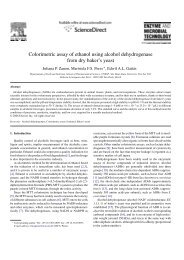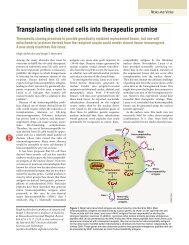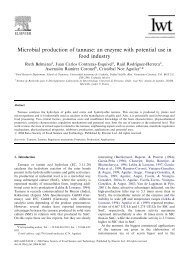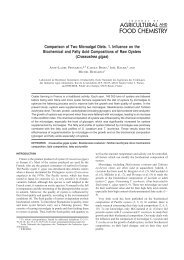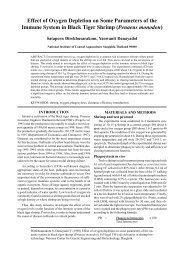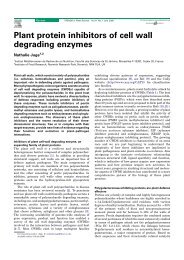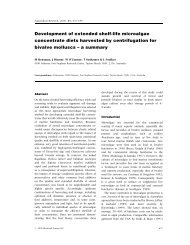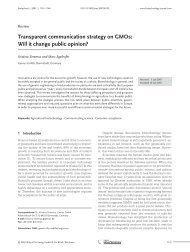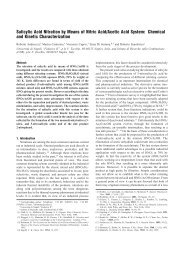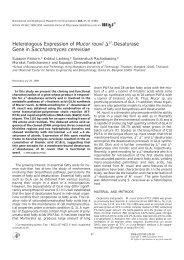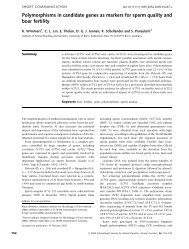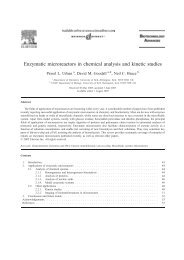Comparison of RAPDs, AFLPs and SSR markers for the genetic ...
Comparison of RAPDs, AFLPs and SSR markers for the genetic ...
Comparison of RAPDs, AFLPs and SSR markers for the genetic ...
Create successful ePaper yourself
Turn your PDF publications into a flip-book with our unique Google optimized e-Paper software.
<strong>the</strong> most efficient <strong>markers</strong> in <strong>the</strong> study. This value may<br />
rise even higher if attempts to optimize this technique<br />
into a single multiple reaction involving all six microsatellites<br />
prove successful.<br />
Ano<strong>the</strong>r important factor to consider when evaluating<br />
marker efficiency is <strong>the</strong> ability to determine relationships<br />
between yeast strains based on an estimation <strong>of</strong><br />
<strong>genetic</strong> similarity (Figs. 4a–c). Genetic similarity coefficients<br />
were obtained (Table 3) <strong>for</strong> all three PCR-derived<br />
techniques,reflecting <strong>the</strong> extreme variability <strong>and</strong> high<br />
resolving power <strong>of</strong> <strong>the</strong>se methods. These same results,<br />
including lower similarity estimates <strong>for</strong> <strong>SSR</strong> analysis<br />
than <strong>for</strong> both <strong>RAPDs</strong> <strong>and</strong> <strong>AFLPs</strong>,have been reported<br />
in equivalent studies per<strong>for</strong>med using o<strong>the</strong>r organisms<br />
(in soybean, Powell et al.,1996; in maize, Pejic et al.,<br />
1998; in Musa, Crouch et al.,1999). These findings<br />
suggest that differences exist between a technique that<br />
amplifies unique sequences,such as microsatellite<br />
analysis,<strong>and</strong> o<strong>the</strong>r methods that amplify multiple<br />
sequences,such as RAPD <strong>and</strong> AFLP techniques.<br />
Poor correlation between estimates <strong>of</strong> <strong>genetic</strong> similarity<br />
based on <strong>the</strong> three different techniques evaluated<br />
in this study indicates that <strong>the</strong>se methods may selectively<br />
screen <strong>for</strong> different regions <strong>of</strong> <strong>the</strong> genome. To fur<strong>the</strong>r<br />
explore this issue,as well as <strong>the</strong> close similarity between<br />
<strong>the</strong> strains assayed,a greater number <strong>of</strong> loci should be<br />
analysed. In an ef<strong>for</strong>t to increase <strong>the</strong> integrity <strong>of</strong> our<br />
analysis,a single dendrogram was constructed that<br />
combines <strong>the</strong> in<strong>for</strong>mation obtained from all three<br />
marker types (Fig. 4d). This <strong>genetic</strong> tree revealed that<br />
only <strong>the</strong> topology <strong>of</strong> some groupings is conserved,with<br />
non-significant groups appearing r<strong>and</strong>om regardless <strong>of</strong><br />
<strong>the</strong> number <strong>of</strong> <strong>markers</strong> studied. Fur<strong>the</strong>r physiological<br />
experimentation is needed in order to determine if <strong>the</strong><br />
conserved groups are correlated with traits <strong>of</strong> interest.<br />
Based on <strong>the</strong> results <strong>of</strong> this study,RAPD <strong>markers</strong><br />
were <strong>the</strong> least polymorphic <strong>markers</strong> <strong>of</strong> those evaluated,<br />
<strong>and</strong> consequently had <strong>the</strong> least resolving power.<br />
Although <strong>the</strong> amount <strong>of</strong> variability detected with<br />
RAPD analysis is dependent upon <strong>the</strong> selection <strong>of</strong><br />
appropriate primers,this method has <strong>the</strong> advantage <strong>of</strong><br />
being inexpensive <strong>and</strong> simple to per<strong>for</strong>m,<strong>and</strong> does not<br />
require a previous knowledge <strong>of</strong> <strong>the</strong> genome. Problems<br />
with reproducibility have plagued <strong>the</strong> use <strong>of</strong> this<br />
technique in <strong>the</strong> past,due to <strong>the</strong> low temperature <strong>of</strong><br />
<strong>the</strong> hybridization <strong>of</strong> <strong>the</strong> primers. However,we were able<br />
to limit <strong>the</strong>se problems in this study,as evidenced by <strong>the</strong><br />
results <strong>of</strong> our duplicate analysis,by careful DNA<br />
preparation,strict adherence to amplification protocols<br />
<strong>and</strong> a rigorous interpretation <strong>of</strong> <strong>the</strong> results.<br />
The AFLP technique resulted in high resolution <strong>and</strong><br />
good reproducibility in this study,a finding substantiated<br />
by <strong>the</strong> recent use <strong>of</strong> AFLP <strong>markers</strong> in <strong>the</strong><br />
identification <strong>and</strong> intraspecific differentiation <strong>of</strong> S.<br />
cerevisiae strains (deBarros Lopes et al.,1999). This<br />
technique,however,is much more technically complex<br />
ARTICLE IN PRESS<br />
F. Javier Gallego et al. / Food Microbiology 22 (2005) 561–568 567<br />
than <strong>the</strong> use <strong>of</strong> <strong>SSR</strong> <strong>markers</strong>,requiring numerous<br />
experimental steps at a higher cost per in<strong>for</strong>mative<br />
marker. Despite <strong>the</strong>se limitations,<strong>the</strong> AFLP technique<br />
has great value as a tool <strong>for</strong> use in <strong>genetic</strong> mapping <strong>and</strong><br />
evolutionary studies,as it can test a large number <strong>of</strong> loci<br />
distributed r<strong>and</strong>omly throughout a genome. Unlike<br />
microsatellites,AFLP <strong>markers</strong> are not highly variable,<br />
providing a less biased estimate <strong>of</strong> population variability.<br />
<strong>SSR</strong> analysis revealed <strong>the</strong> highest <strong>genetic</strong> variability in<br />
<strong>the</strong> microbial population studied,also achieving <strong>the</strong><br />
greatest discriminatory power. It also proved to be <strong>the</strong><br />
most efficient method,with <strong>the</strong> highest number <strong>of</strong><br />
effective alleles per assay. We also found <strong>the</strong> results <strong>of</strong><br />
<strong>SSR</strong> to be faster <strong>and</strong> easier to interpret than <strong>the</strong> o<strong>the</strong>r<br />
techniques studied,making it an ideal technique <strong>for</strong> use<br />
in <strong>the</strong> characterization <strong>and</strong> identification <strong>of</strong> S. cerevisiae<br />
strains. Successful <strong>SSR</strong> analysis,however,depends on<br />
<strong>the</strong> proper design <strong>and</strong> syn<strong>the</strong>sis <strong>of</strong> primers,requiring a<br />
considerable amount <strong>of</strong> ef<strong>for</strong>t in <strong>the</strong> selection <strong>of</strong><br />
polymorphic microsatellites that af<strong>for</strong>d specific amplifications.<br />
Our study benefited from an available panel <strong>of</strong><br />
six microsatellite loci <strong>and</strong> <strong>the</strong> appropriate primers<br />
needed <strong>for</strong> its specific amplification (Pe´ rez et al.,2001).<br />
In summary,<strong>SSR</strong> amplifications is a simple <strong>and</strong><br />
effective method,with a high degree <strong>of</strong> discrimination<br />
<strong>and</strong> reproducibility,that can be used in <strong>the</strong> identification<br />
<strong>and</strong> intraspecific differentiation <strong>of</strong> S. cerevisiae strains,a<br />
species <strong>of</strong> great importance in industrial fermentations.<br />
Acknowledgments<br />
This research was supported by grants SC94-126 from<br />
<strong>the</strong> Programa Sectorial I+D Agrario y Alimentario <strong>and</strong><br />
RM00-001 from <strong>the</strong> Accio´ n Estratégica ‘‘Conservacio´ n<br />
de los recursos gene´ ticos de interés agroalimentario’’ del<br />
Plan Nacional de Investigacio´ n Cientı´ fica,Desarrollo e<br />
Innovacio´ n Tecnolo´ gica (I+D+I) from <strong>the</strong> Instituto<br />
Nacional de Investigacio´ n y Tecnologı´ a Agraria y<br />
Alimentaria (INIA) (Spain).<br />
References<br />
Cenı´ s,J.L.,Sánchez Escribano,E.M.,1999. Evaluación de cuatro<br />
te´ cnicas genéticas de identificación (isoenzimas,<strong>RAPDs</strong>,microsate´<br />
lites y <strong>AFLPs</strong>) en variedades de uva de mesa. In: Identificación<br />
molecular de germoplasma de vid. Jornadas de Agronomía. IMIA,<br />
Comunidad de Madrid,pp. 129–144.<br />
Crouch,J.H.,Crouch,H.K.,Const<strong>and</strong>i,H.,Van Gysel,A.,Breyne,P.,<br />
Van Montagu,M.,Jarret,R.L.,Ortiz,R.,1999. <strong>Comparison</strong> <strong>of</strong><br />
PCR-based molecular marker analyses <strong>of</strong> Musa breeding populations.<br />
Mol. Breed. 5,233–244.<br />
deBarros Lopes,M.,Soden,A.,Henschke,P.A.,Langridge,P.,1996.<br />
PCR differentiation <strong>of</strong> commercial yeast strains using intro splice<br />
site primers. Appl. Environ. Microbiol. 62,4514–4520.




